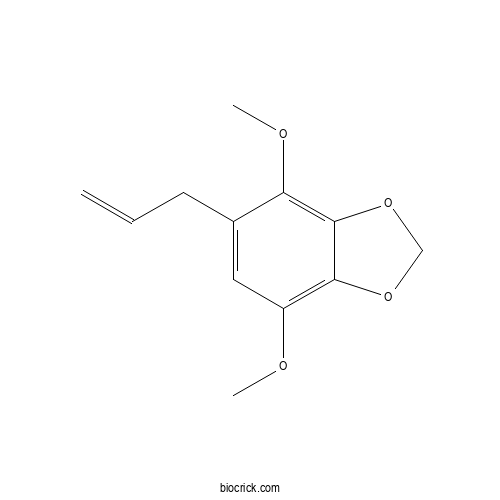ApiolineCAS# 523-80-8 |

Quality Control & MSDS
3D structure
Package In Stock
Number of papers citing our products

| Cas No. | 523-80-8 | SDF | Download SDF |
| PubChem ID | 10659 | Appearance | Powder |
| Formula | C12H14O4 | M.Wt | 222.2 |
| Type of Compound | Phenols | Storage | Desiccate at -20°C |
| Solubility | Soluble in Chloroform,Dichloromethane,Ethyl Acetate,DMSO,Acetone,etc. | ||
| Chemical Name | 4,7-dimethoxy-5-prop-2-enyl-1,3-benzodioxole | ||
| SMILES | COC1=C2C(=C(C(=C1)CC=C)OC)OCO2 | ||
| Standard InChIKey | QQRSPHJOOXUALR-UHFFFAOYSA-N | ||
| Standard InChI | InChI=1S/C12H14O4/c1-4-5-8-6-9(13-2)11-12(10(8)14-3)16-7-15-11/h4,6H,1,5,7H2,2-3H3 | ||
| General tips | For obtaining a higher solubility , please warm the tube at 37 ℃ and shake it in the ultrasonic bath for a while.Stock solution can be stored below -20℃ for several months. We recommend that you prepare and use the solution on the same day. However, if the test schedule requires, the stock solutions can be prepared in advance, and the stock solution must be sealed and stored below -20℃. In general, the stock solution can be kept for several months. Before use, we recommend that you leave the vial at room temperature for at least an hour before opening it. |
||
| About Packaging | 1. The packaging of the product may be reversed during transportation, cause the high purity compounds to adhere to the neck or cap of the vial.Take the vail out of its packaging and shake gently until the compounds fall to the bottom of the vial. 2. For liquid products, please centrifuge at 500xg to gather the liquid to the bottom of the vial. 3. Try to avoid loss or contamination during the experiment. |
||
| Shipping Condition | Packaging according to customer requirements(5mg, 10mg, 20mg and more). Ship via FedEx, DHL, UPS, EMS or other couriers with RT, or blue ice upon request. | ||
| Description | Reference standards. | |||||

Apioline Dilution Calculator

Apioline Molarity Calculator
| 1 mg | 5 mg | 10 mg | 20 mg | 25 mg | |
| 1 mM | 4.5005 mL | 22.5023 mL | 45.0045 mL | 90.009 mL | 112.5113 mL |
| 5 mM | 0.9001 mL | 4.5005 mL | 9.0009 mL | 18.0018 mL | 22.5023 mL |
| 10 mM | 0.45 mL | 2.2502 mL | 4.5005 mL | 9.0009 mL | 11.2511 mL |
| 50 mM | 0.09 mL | 0.45 mL | 0.9001 mL | 1.8002 mL | 2.2502 mL |
| 100 mM | 0.045 mL | 0.225 mL | 0.45 mL | 0.9001 mL | 1.1251 mL |
| * Note: If you are in the process of experiment, it's necessary to make the dilution ratios of the samples. The dilution data above is only for reference. Normally, it's can get a better solubility within lower of Concentrations. | |||||

Calcutta University

University of Minnesota

University of Maryland School of Medicine

University of Illinois at Chicago

The Ohio State University

University of Zurich

Harvard University

Colorado State University

Auburn University

Yale University

Worcester Polytechnic Institute

Washington State University

Stanford University

University of Leipzig

Universidade da Beira Interior

The Institute of Cancer Research

Heidelberg University

University of Amsterdam

University of Auckland

TsingHua University

The University of Michigan

Miami University

DRURY University

Jilin University

Fudan University

Wuhan University

Sun Yat-sen University

Universite de Paris

Deemed University

Auckland University

The University of Tokyo

Korea University
- Cevadine
Catalog No.:BCN9937
CAS No.:62-59-9
- Carvacrol methyl ether
Catalog No.:BCN9936
CAS No.:6379-73-3
- 2,4-Dimethylphenol
Catalog No.:BCN9935
CAS No.:105-67-9
- Nortropinone hydrochloride
Catalog No.:BCN9934
CAS No.:25602-68-0
- Sodium pyruvate
Catalog No.:BCN9933
CAS No.:113-24-6
- 3-Carene
Catalog No.:BCN9932
CAS No.:13466-78-9
- Pseudopelletierine hydrochloride
Catalog No.:BCN9931
CAS No.:6164-62-1
- 6-Methoxyflavone
Catalog No.:BCN9930
CAS No.:26964-24-9
- (+)-Dihydrocinchonine
Catalog No.:BCN9929
CAS No.:485-65-4
- 4-Phenylmorpholine
Catalog No.:BCN9928
CAS No.:92-53-5
- Sanguinarine nitrate
Catalog No.:BCN9927
CAS No.:4752-86-7
- trans-Stilbene
Catalog No.:BCN9926
CAS No.:103-30-0
- Oleacein
Catalog No.:BCN9939
CAS No.:149183-75-5
- Enterodiol
Catalog No.:BCN9940
CAS No.:77756-22-0
- Coniine hydrochloride
Catalog No.:BCN9941
CAS No.:15991-59-0
- Ethyl salicylate
Catalog No.:BCN9942
CAS No.:118-61-6
- 3',4',5'-Trimethoxyflavone
Catalog No.:BCN9943
CAS No.:67858-30-4
- 1-Phenylethanol
Catalog No.:BCN9944
CAS No.:98-85-1
- Hyoscyamine hydrobromide
Catalog No.:BCN9945
CAS No.:306-03-6
- 2',4'-Dihydroxydihydrochalcone
Catalog No.:BCN9946
CAS No.:53596-71-7
- Pipermethystine
Catalog No.:BCN9947
CAS No.:71627-22-0
- 2,4-Dihydroxybenzoic acid
Catalog No.:BCN9948
CAS No.:89-86-1
- Petroselinic acid
Catalog No.:BCN9949
CAS No.:593-39-5
- Manassantin B
Catalog No.:BCN9950
CAS No.:88497-88-5
[Chemical composition and allelopathic potential of essential oil isolated from Origanum vulgare].[Pubmed:32715689]
Ying Yong Sheng Tai Xue Bao. 2020 Jul;31(7):2257-2263.
This study aimed to explore the chemical composition of essential oil isolated from Origanum vulgare and investigated its allelopathic potential. The essential oil isolated by hydro-distillation from the whole plant of O. vulgare was analyzed by GC and GC-MS. Fourteen different components were identified, constituting 93.56% of the total area of peaks. The major components were methyleugenol (16.5%), myristicin (15.6%), carvacrol (15.0%), thymol (9.8%), and Apioline (9.4%). We examined the inhibitory effects of essential oil on seed germination and seedling growth of wheat (Triticum aestivum), mung bean (Vigna radiata), and radish (Raphanus sativus). The results showed that essential oil of O. vulgare inhibited seed germination of all tested crops, with wheat being the most susceptible, followed by radish and mung bean. The inhibitory effects of essential oil on growth of the aboveground part of tested crops were greater than that of underground part. The inhibitory effects of essential oil on the seedling length of all tested crops increased in a dose-dependent manner, with the same pattern for radicle length of wheat and radish as well. Meanwhile, essential oil could stimulate radicle growth of V. radiata at low concentration, but inhibit the growth at high concentration. Our results confirmed the existence of allelochemicals in the essential oil of O. vulgare. However, what the compounds will be and how about their allelopathic mechanism needs further investigation.


